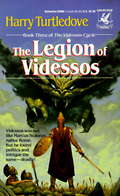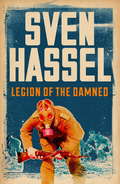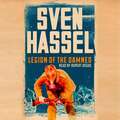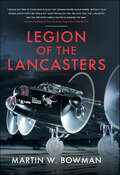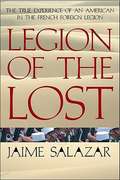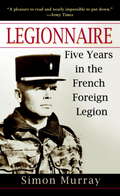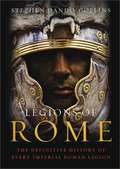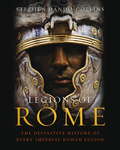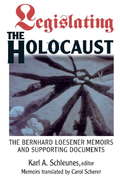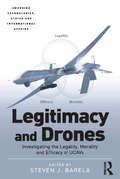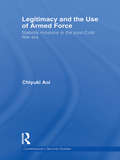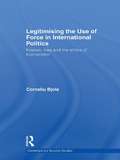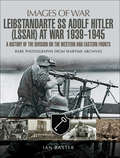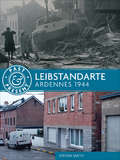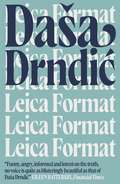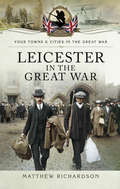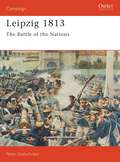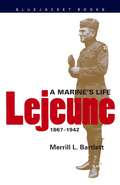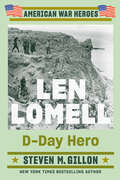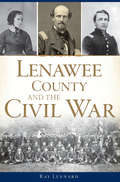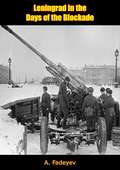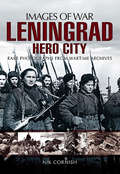- Table View
- List View
Legion of Videssos
by Harry TurtledoveSince the Roman legion had been mysteriously transported to this world of magic, tribune Marcus Scaurus had served the rulers of war-torn Videssos well. He had been largely responsible for ousting the Pretender and putting Thorish Gavras on the throne. That, of course, made him a hero.Rome or Videssos, however, Fortune was a fickle goddess.Now he and the legion were returning in triumph to Videssos the city after defeating a well-entrenched army of rebel mercenaries. But Marcus, betrayed by the one closest to him, was returning to be seized, dragged before the Emperor, and questioned under truth-drug like a traitor.Of the court, only Alypia Gavra stuck by him -- but consorting with the Emperor's niece was dangerous. It could lead to exile -- or death!Yet Alypia was attractive. And Marcus was lonely . . .From the Paperback edition.
Legion of the Brave
by D. P. RamachandranSights and sounds of a glorious fortnight - tank pennants fluttering in the wild amidst the dust and fury of the battle, the gleam of the bayonets and the echo of the battle-cry as a barrage was laid ...... Bangladesh, 1971, a legend is born.
Legion of the Damned
by Sven HasselSven Hassel's iconic war novel about the Russian Front.'An extraordinary book, which has captured the attention of all of Europe' - NEW YORK TIMES'LEGION OF THE DAMNED is an incredible picture of totalitarianism, of stupefying injustice ... He is graphic, at times brilliantly so, but never brutal or bitter. He is, too, a first-rate storyteller' - WASHINGTON POSTConvicted of deserting the German army, Sven Hassel is sent to a penal regiment on the Russian Front. He and his comrades are regarded as expendable, cannon fodder in the battle against the implacable Red Army. Outnumbered and outgunned, they fight their way across the frozen steppe...This iconic anti-war novel is a testament to the atrocities suffered by the lone soldier in the fight for survival.Sven Hassel's unflinching narrative is based on his own experiences in the German Army. He began writing his first novel, LEGION OF THE DAMNED in a prisoner of war camp at the end of the Second World War.
Legion of the Damned (Sven Hassel War Classics)
by Sven HasselAn extraordinary book, which has captured the attention of all of Europe' - NEW YORK TIMES'LEGION OF THE DAMNED is an incredible picture of totalitarianism, of stupefying injustice ... He is graphic, at times brilliantly so, but never brutal or bitter. He is, too, a first-rate storyteller' - WASHINGTON POSTConvicted of deserting the German army, Sven Hassel is sent to a penal regiment on the Russian Front. He and his comrades are regarded as expendable, cannon fodder in the battle against the implacable Red Army. Outnumbered and outgunned, they fight their way across the frozen steppe...This iconic anti-war novel is a testament to the atrocities suffered by the lone soldier in the fight for survival.Sven Hassel's unflinching narrative is based on his own experiences in the German Army. He began writing his first novel, LEGION OF THE DAMNED in a prisoner of war camp at the end of the Second World War.Read by Rupert Degas(p) 2014 Orion Publishing Group
Legion of the Lancasters
by Martin W. BowmanSöthe had already decided to use his nose armament against the 4-mot [four engined bomber]. He looked out and focused on a black shape of the Britisher. Small, bluish exhaust flames made it easier to keep the target in sight. Four engines, twin tail were recorded almost subconsciously. No sudden movement that might attract their attention. Calm now! Guns armed? Night sight switched on? Everything OK! Now he could see that it was a Lancaster, crossing gently from starboard to port. He applied a little more power and approached cautiously. Now he was exactly behind him at about 100 metres’ range. The rear turret was clearly recognisable. Brönies kept silent. ‘Pauke! Pauke!’ [‘Kettledrums! Kettledrums!’] Söthe announced with a cry. Brönies immediately transmitted ‘Ich beruhe’. Then they closed in rapidly for the kill. One can almost smell the flak, taste the cordite and experience the nervous ‘twitch’ before jumping out of one’s skin to the sound of exploding shells and detonating bombs in this pulsating and highly intriguing selection of never-before-told stories recalled largely by members of the revered Lancaster crews of RAF Bomber Command. From this bomber’s introduction into service in 1942 with the famous if flawed raid on Augsburg on 17 April that year, to the attacks on the Tirpitz in 1944, each chapter is a tribute to the spirit of those who flew the ‘Lanc’ in anger and gained the respect of their enemies.
Legion of the Lost
by Jaime SalazarThe son of underpaid Mexican immigrants, Jaime earned a degree in mechanical engineering from Purdue. But at twenty-three, he was disillusioned with the corporate fast track. So he became an outcast American in a hard-bitten group of recruits-men on the run from their pasts, men without hope: He joined the French Foreign Legion. From the Legion's notoriously brutal training to Salazar's fierce competitiveness, ultimate disillusionment and dramatic desertion, Legion of the Lost is a compelling, firsthand account of today's French Foreign Legion that will dispel myths while adding to the legend of the finest trained army of warriors the world has ever known.
Legionnaire: Five Years in the French Foreign Legion
by Simon MurraySimon Murray was nineteen when he joined the French Foreign Legion. Inspired by the romantic myths of Beau Geste, he found himself in the ranks of one of the world's greatest - and toughest - fighting forces. He kept a unique diary of the hard living, harsh discipline, and the military tradition of 'March or Die' which he turned into this gripping book. 'Simon Murray's personal account of a gently reared, well-educated British youth's coming of age in the French Foreign Legion has the drama, excitement and colour of a good guts-and-glory thriller ... Murray is a talented storyteller, and his fellow legionnaires and their disciplined and proud Corps are vividly portrayed. I was hooked from the first page.' Dr. Henry Kissinger. 'One of the greatest adventure stories in recent years.' Chris Patten.
Legions of Rome
by Stephen Dando-CollinsNo book on Roman history has attempted to do what Stephen Dando-Collins does in Legions of Rome: to provide a complete history of every Imperial Roman legion and what it achieved as a fighting force. The author has spent the last thirty years collecting every scrap of available evidence from numerous sources: stone and bronze inscriptions, coins, papyrus and literary accounts in a remarkable feat of historical detective work.The book is divided into three parts: Part 1 provides a detailed account of what the legionaries wore and ate, what camp life was like, what they were paid and how they were motivated and punished. The section also contains numerous personal histories of individual soldiers. Part 2 offers brief unit histories of all the legions that served Rome for 300 years from 30BC. Part 3 is a sweeping chronological survey of the campaigns in which the armies were involved, told from the point of view of particular legions.Lavish, authoritative and beautifully produced, Legions of Rome will appeal to ancient history enthusiasts and military history buffs alike.
Legions of Rome: The definitive history of every Roman legion
by Stephen Dando-CollinsNo book on Roman history has attempted to do what Stephen Dando-Collins does in Legions of Rome: to provide a complete history of every Imperial Roman legion and what it achieved as a fighting force. The author has spent the last thirty years collecting every scrap of available evidence from numerous sources: stone and bronze inscriptions, coins, papyrus and literary accounts in a remarkable feat of historical detective work. The book is divided into three parts: Part 1 provides a detailed account of what the legionaries wore and ate, what camp life was like, what they were paid and how they were motivated and punished. The section also contains numerous personal histories of individual soldiers. Part 2 offers brief unit histories of all the legions that served Rome for 300 years from 30BC. Part 3 is a sweeping chronological survey of the campaigns in which the armies were involved, told from the point of view of particular legions. Lavish, authoritative and beautifully produced, Legions of Rome will appeal to ancient history enthusiasts and military history buffs alike.
Legions of Rome: The definitive history of every Roman legion
by Stephen Dando-CollinsNo book on Roman history has attempted to do what Stephen Dando-Collins does in Legions of Rome: to provide a complete history of every Imperial Roman legion and what it achieved as a fighting force. The author has spent the last thirty years collecting every scrap of available evidence from numerous sources: stone and bronze inscriptions, coins, papyrus and literary accounts in a remarkable feat of historical detective work. The book is divided into three parts: Part 1 provides a detailed account of what the legionaries wore and ate, what camp life was like, what they were paid and how they were motivated and punished. The section also contains numerous personal histories of individual soldiers. Part 2 offers brief unit histories of all the legions that served Rome for 300 years from 30BC. Part 3 is a sweeping chronological survey of the campaigns in which the armies were involved, told from the point of view of particular legions. Lavish, authoritative and beautifully produced, Legions of Rome will appeal to ancient history enthusiasts and military history buffs alike.
Legislating The Holocaust
by Karl SchleunesFrom April 1933 to early 1943, Bernard Loesener served as the official "Jewish Expert" in the German Third Reich's Ministry of the Interior, the government body responsible for the Nazi's legislative assault on German Jewry. In that role, he personally drafted much of the legislation, the Nuremberg Laws of 1935 preeminently, that gradually dispossessed, disenfranchised, and dehumanized the Jews of Nazi Germany. During the first six years of Nazi rule, the seminal period of government-sponsored anti-Semitism, Loesener kept the minutes of many crucial, high-level, inter-ministerial conferences concerned with the "Jewish Question." As observer and participant, his experiences were virtually unparalleled. In 1950, Loesener penned a memoir that sought to explain, and justify, his actions during the ten-year escalation of Nazi oppression that resulted, to Loesener's professed horror, in the Final Solution. It was published in 1961, in German, by the journal Vierteljahrshefte fuer Zeitgeschichte. It has never before appeared in English, until now - in Legislating the Holocaust.
Legitimacy and Drones: Investigating the Legality, Morality and Efficacy of UCAVs (Emerging Technologies, Ethics and International Affairs)
by Steven J. BarelaUnmanned combat air vehicles, or in common parlance 'drones', have become a prominent instrument in US efforts to counter an objective (and subjective) cross-border terrorist threat with lethal force. As a result, critical questions abound on the legitimacy of their use. In a series of multidisciplinary essays by scholars with an extensive knowledge of international norms, this book explores the question of legitimacy through the conceptual lenses of legality, morality and efficacy, it then closes with the consideration of a policy proposal aimed at incorporating all three indispensable elements. The importance of this inquiry cannot be overstated. Non-state actors fully understand that attacking the much more powerful state requires moving the conflict away from the traditional battlefield where they are at an enormous disadvantage. Those engaging in terrorism seek to goad the ruling government into an overreaction, or abuse of power, to trigger a destabilization via an erosion of its legitimacy. Thus defending the target of legitimacy”in this case, insuring the use of deadly force is constrained by valid limiting principles”represents an essential strategic interest. This book seeks to come to grips with the new reality of drone warfare by exploring if it can be used to preserve, rather than eat away at, legitimacy. After an extensive analysis of the three key parameters in twelve chapters, the practical proposition of establishing a 'Drone Court' is put forward and examined as a way of pursuing the goal of integrating these essential components to defend the citizenry and the legitimacy of the government at the same time.
Legitimacy and the Use of Armed Force: Stability Missions in the Post-Cold War Era (Contemporary Security Studies)
by Chiyuki AoiThis book examines the concept of legitimacy as it may be used to explain the success, or failure, of key stability operations since the end of the Cold War. In the success of stability operations, legitimacy is key. In order to achieve success, the intervening force must create a sense of legitimacy of the mission among the various constituencies concerned with and involved in the venture. These parties include the people of the host nation, the host government (whose relations with the local people must be legitimate), political elites and the general public worldwide—including the intervening parties’ own domestic constituencies, who will sustain (or not sustain) the intervention by offering (or withdrawing) support. This book seeks to bring into close scrutiny the legitimacy of stability interventions in the post-Cold War era, by proposing a concept that captures both the multi-faceted nature of legitimacy and the process of legitimation that takes place in each case. Case studies on Liberia, Bosnia, Somalia, Rwanda, Afghanistan and Iraq explain how legitimacy related to the outcome of these operations. This book will be of much interest to students of stability operations, counterinsurgency, peace operations, humanitarian intervention, and IR/security studies in general.
Legitimate Targets?
by Janina DillBased on an innovative theory of international law, Janina Dill's book investigates the effectiveness of international humanitarian law (IHL) in regulating the conduct of warfare. Through a comprehensive examination of the IHL defining a legitimate target of attack, Dill reveals a controversy among legal and military professionals about the 'logic' according to which belligerents ought to balance humanitarian and military imperatives: the logics of sufficiency or efficiency. Law prescribes the former, but increased recourse to international law in US air warfare has led to targeting in accordance with the logic of efficiency. The logic of sufficiency is morally less problematic, yet neither logic satisfies contemporary expectations of effective IHL or legitimate warfare. Those expectations demand that hostilities follow a logic of liability, which proves impracticable. This book proposes changes to international law, but concludes that according to widely shared normative beliefs, on the twenty-first-century battlefield there are no truly legitimate targets.
Legitimising the Use of Force in International Politics: Kosovo, Iraq and the Ethics of Intervention (Contemporary Security Studies)
by Corneliu BjolaThis book aims to examine the conditions under which the decision to use force can be reckoned as legitimate in international relations. Drawing on communicative action theory, it provides a provocative answer to the hotly contested question of how to understand the legitimacy of the use of force in international politics. The use of force is one of the most critical and controversial aspects of international politics. Scholars and policy-makers have long tried to develop meaningful standards capable of restricting the use of force to a legally narrow yet morally defensible set of circumstances. However, these standards have recently been challenged by concerns over how the international community should react to gross human rights abuses or to terrorist threats. This book argues that current legal and moral standards on the use of force are unable to effectively deal with these challenges. The author argues that the concept of 'deliberative legitimacy', understood as the non-coerced commitment of an actor to abide by a decision reached through a process of communicative action, offers the most appropriate framework for addressing this problem. The theoretical originality and empirical value of the concept of deliberative legitimacy comes fully into force with the examination of two of the most severe international crises from the post Cold War period: the 1999 NATO intervention in Kosovo and the 2003 US military action against Iraq. This book will be of much interest to students of international security, ethics, international law, discourse theory and IR. Corneliu Bjola is SSHRC Postdoctoral Fellow with the Centre for Ethics at the University of Toronto, and has a PhD in International Relations.
Leibstandarte SS Adolf Hitler: A History of the Division on the Western and Eastern Fronts (Images of War)
by Ian BaxterWith extensive text and many unpublished photographs with in-depth captions - the successful Images of War format - this book describes the Divisions fighting tactics, weapons and uniforms. It traces how the Division became an elite fighting unit both in offensive and defensive battles.The Division is shown as it battled its way through Poland, the Low Countries, the Balkans and then on the Eastern Front, where it fought tenaciously for Kharkov and in the 1943 battle of Kursk. In 1944 it was deployed to Normandy before the carnage of the Falaise Pocket. Soon after it was back in action during the bitter winter fighting in the Ardennes, before returning to the Eastern Front where it was shifted from one disintegrating part of the front to another. The Leibstandarte SS Adolf Hitler (LSSAH) provides a captivating glimpse of the history and inner workings of one of the most effective fighting formations of the Second World War.
Leibstandarte: Ardennes 1944 (Past & Present)
by Stephen Smith Simon FortyThe missions and massacres of the infamous panzer division that spearheaded the German Ardennes Offensive in the Battle of the Bulge.From the outset of the offensive, launched on a snowy December 16, the 1st SS Panzer Division Leibstandarte Adolf Hitler faced difficulties. It captured a fuel dump at Büllingen, but brave defense forced Commander Joachim Peiper onto tight, winding roads that proved difficult to negotiate and soon the battle group was strung out over 25 kilometers with its heavy armor—the King Tigers—slowly losing ground as vehicle after vehicle succumbed to automotive failures. Pushing through Stavelot and Trois Pont, the advanced units of the battle group reached Stoumont before lack of fuel—the Americans had retaken Stavelot and closed off the route for German resupply—and US Army action forced it to halt at La Gleize. Six days later, on Christmas Eve, with no hope and no fuel, Peiper and his men abandoned their vehicles and made their way back to their lines: only 770 got there.They left behind 135 armored vehicles including the King Tiger that today stands in front of the museum at La Gleize. They also left scattered on their route the murdered bodies of US servicemen—at Malmedy, Ligneuville, and Wereth—and civilians, massacres that would lead to postwar trials and continued recriminations.The Past & Present Series reconstructs historical battles by using photography, juxtaposing modern views with those of the past together with concise explanatory text. It shows how much infrastructure has remained and how much such as outfits, uniforms, and ephemera has changed, providing a coherent link between now and then.
Leica Format
by Daša DrndicThis is like a fairy tale, all this. A woman meets a stranger who tells her her identity is a lie. 772 (or 789) children's brains rest silently in jars. A traveller comes to a quotidian city, unknowingly approaching her past. From the author of Trieste (shortlisted for the Independent Foreign Fiction Prize) comes this bedazzling kaleidoscopic novel, stitching together fact and fiction, history and memory, words and images into a heart-breaking collage that manages to look askance at the blinding horror of history. Ranging across themes of memory, loss, inheritance and storytelling, Drndic borrows from every tradition of writing to weave together a fragmented narrative of love and disease, in a novel that's very format raises penetrating and unanswerable questions about history, and the processes by which we describe and remember it.
Leicester in the Great War (Your Towns & Cities in the Great War)
by Matthew RichardsonLeicester had a strong radical tradition, and was represented in Parliament during the Great War by the outspoken Labour MP Ramsay MacDonald. MacDonald's anti-war views divided opinion in Leicester sharply, but whilst it was slow to provide troops for Kitchener's Army, this was not through lack of patriotism. Instead, Leicester's three main industries footwear, hosiery and engineering all had bulging order books as a result of government war contracts.Bravery on the battlefield, strikes at home, conscientious objectors and the great flu pandemic were all part of Leicester's story in the Great War, and all are covered here. The author allows Leicester citizens, who lived through these momentous events, to tell their stories in their own words, and powerful eyewitness accounts from men, women and children run through this book. Many of these accounts are previously unpublished, and lend a sense of freshness and immediacy to the narrative, making this an ideal purchase for First World War enthusiasts and social historians alike.
Leipzig 1813
by Peter HofschröerThe battle of Leipzig was, in terms of the number of combatants involved, the largest engagement of the entire Napoleonic Wars (1799-1815). It was the only battle of the wars in which all Allied armies (including even the Swedes) fielded troops against Napoleon. Peter Hofschroer looks at the run-up to this crucial encounter as well as the battle itself. A wealth of background information is chronicled, including the strategies of both sides and detailed information on each of the combatant forces. The numerous battles leading up to Leipzig are also discussed, providing a fascinating and illuminating overview of the whole campaign.
Lejeune
by Merrill L. BartlettThis well-documented and hard-hitting biography of the thirteenth commandant of the U.S. Marine Corps succeeds in converting John A. Lejeune from a near mythical figure in corps history to a flesh and blood officer who helped build the service from a small appendage of the U.S. Navy to an important arm of naval warfare.Commandant from 1920 to 1929, when he retired from military service to become president of Virginia Military Institute, Major General Lejeune is regarded by many as the man most responsible for the establishment of the modern Marine Corps. In capturing the life and times of this visionary leader who directed the corps toward major amphibious operations, Merrill Bartlett provides vivid insight into the political and military giants of the era and shows Lejeune to be an adroit player of Washington politics and a shrewd manipulator who marshalled the energies and loyalties of his senior officers to accomplish his vision
Len Lomell: D-Day Hero (American War Heroes)
by Steven M. GillonThe exhilarating, inspiring story of Len Lomell, an Army Ranger who on D-Day almost single-handedly knocked out the big German guns before they could fire on the American invasion force, and whose later exploits spanned the most dramatic battles of World War II. Len Lomell was drafted to the United States Army in 1942, became an Army Ranger, and was soon sent to England to prepare for the D-Day invasion. At Point du Hoc, Lomell and his men were given a daunting mission—to scale the steep cliffs and disable the big German guns at the top, guns that could otherwise destroy the rest of the D-Day landing fleet. Despite incredible odds, it was a mission that Lomell completed almost single-handedly. In this stirring, action-packed book, Gillon details the incredibly heroic actions on D-Day—and throughout World War II—that ultimately won Lomell the Distinguished Service Cross, a Silver Star, and a Bronze Star. Lomell was later praised by Stephen Ambrose as the single most important person in the success of D-Day after General Eisenhower. With propulsive writing, nuanced research, and multiple personal interviews with Lomell, Gillon brings an unforgettable WWII hero to life, finally giving him the recognition he so richly deserves.
Lenawee County and the Civil War (Civil War Series)
by Ray LennardLenawee County was a hotbed for antislavery activities in the 1830s that translated into strong Union support in April 1861. Adrian, Tecumseh and Hudson sent hundreds of soldiers to fight and die in the Civil War. The Emancipation Proclamation propelled nearly fifty of the county's African American residents to take up arms to preserve the nation and end slavery once and for all. Captain Samuel DeGolyer, creator of the Lenawee Guard, escaped Confederate prison in Richmond. On the homefront, residents like Laura and Charles Haviland sheltered fugitive slaves and even donated land to help families start anew. Join author Ray Lennard as he explores the events of the war that changed Lenawee County and the nation forever.
Leningrad in the Days of the Blockade
by R. D. Charques A. FadeyevThe 900 day siege of Leningrad (now St. Petersburg) on the Baltic was perhaps one of the most iconic clashes of Nazi versus Soviet clashes to take place during the Second World War. Two and a half million Russians were trapped and encircled by Germand and Finnish forces, but despite freezing cold, scant supplies and little if any food, the city held out. In this book, noted Soviet author Alexander Alexandrovitch Fadeyev gives an eyewitness account of the horrific conditions of the city in the iron jaws of the Wehrmacht.
Leningrad: Hero City (Images of War)
by Nik CornishThe 900-day siege of the Soviet city of Leningrad by the combined forces of the Germans and the Finns is one of the most remarkable, and terrible, events of the Second World War, yet until recently it has not received the attention it deserves it has been overshadowed by other massive confrontations on the Eastern Front, at Stalingrad and Kursk. And rarely has the compelling story of the siege been told through graphic wartime photographs like those that author Nik Cornish has collected for this book. Many of these images have not been published before, and they give an unflinching insight into the reality of the conditions of the siege as it was experienced by the soldiers on each side and by the civilians trapped in the city who were threatened by starvation, disease, shelling and assault. The entire course of the siege is covered, from the encirclement of September 1941, through the successive attempts by the Wehrmacht to break in and the dogged, sometimes desperate defense put up by the Red Army, to the withdrawal of the Germans and the lifting of the siege in January 1944. Nik Cornishs portrait of the ruthless struggle of Hitlers armies to capture the second city of the Soviet Union and the determination and suffering of the defenders will be fascinating reading for everyone who is interested in the war on the Eastern Front.
